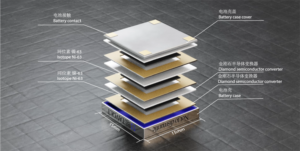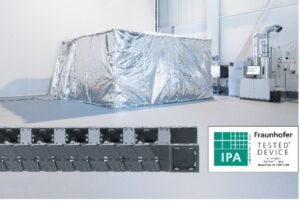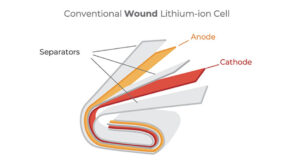Cold starts, hot power markets, and great expectations Recent cold spells across the United States have shifted the focus from “range anxiety” in electric vehicles (EVs) to concerns about their performance in cold…how they start, and how far they can go. Buzzworthy? Apparently. Newsworthy? Maybe, but it’s not new news. Reflecting on a youthful…
Betavolt achieves miniaturization of atomic batteries with 50-year autonomy
Editor’s note: Read more and watch colleague James Anderton on engineering.com TV describe what this “nuclear battery” means to you and me and the charging cords we carry — or not. Check it out here. Beijing’s Betavolt New Energy Technology Co., Ltd. announced a miniature atomic energy battery that combines nickel 63 nuclear isotope decay…
Lithium Iron Phosphate cell capable of charging from 20% to 80% in six minutes
DESTEN Inc. announced the launch of the latest cell technology advancement, an Ultra-Fast Charging, 6C LFP (Lithium Iron Phosphate) cell. The latest pouch form-factor cell from DESTEN is capable of charging from 20% to 80% SOC in 6 minutes. Owing to its LFP-based chemistry, this cell features an impressive chemical and temperature stability profile, making…
October 2023 Issue: Power & Energy Efficiency Handbook
Engineering a green mindset and sustainable future Growing up in the pre-2000s era with a power electronics engineer for a father, my family’s first introduction to power and energy efficiency efforts was primarily analog. The word “vampire” was associated with a TV show called Dark Shadows; it had nothing to do with standby power…
Certified energy chain cable guide system certified with ISO Class 4
Battery production for tomorrow’s mobility requires special environmental conditions, which are achieved through the combination of dry rooms and cleanrooms. The Fraunhofer IPA has developed a new type of certificate for precisely these requirements. The E6.29 energy chain from igus is the very first cable guide system that has been tested under dry cleanroom conditions…
Harnessing silicon: the future of lithium-ion batteries
By Ashok Lahiri, Enovix Corporation The first lithium-ion (Li-ion) battery, developed and commercialized by Sony Corporation in 1991, provided a step-change increase in energy density for its handheld camcorder — a harbinger of the many power-hungry portable electronic devices to come. Without this battery innovation, the brick-size cell phone of the 1980s would never have…
EV basics: Comparing innovative battery chemistries
While lithium-ion battery chemistry dominates the current electric vehicle market, scientists are working to develop innovative battery chemistries that address the known challenges the existing chemistry presents. By Adam Kimmel for Mouser Electronics Sales of electric vehicles (EVs) continue to outpace the overall automotive segment, with EV market shares of 5.2% in Q1 and 5.6%…
Joint development agreement to enhance the domestic battery supply chain for automotive OEMs
6K announced that its 6K Energy division has signed a joint development agreement with Our Next Energy (ONE) to develop and produce the critical battery material that ONE will use in their Gemini and Aries battery platforms. The agreement strengthens the procurement of domestically produced electric vehicle batteries for automotive OEMs manufactured by ONE made with…
Researchers develop method of extracting residual energy from waste batteries
A new approach to extracting residual energy from waste batteries could serve as a starting point for waste reduction research Batteries find use everywhere. But once discharged, they are discarded. For many years, discarded batteries have been salvaged for valuable metals. However, the residual energy in them have seldom been recovered. In a new…
Li battery charger IC features programmable charge parameters
Halo Microelectronics announced the release of its HL7090, a fully automatic and highly integrated lithium battery charging management IC with one switching charger, two linear chargers, and full-range programmable charge parameters through an I2C compatible interface. The HL7090 is a compact, flexible, and high-efficiency switching-mode charge management IC for single-cell Li-ion and Li-polymer batteries used…









